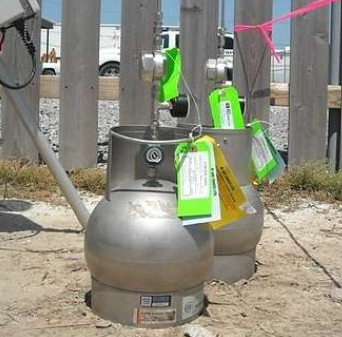Testing Your Home for mVOCs Could Point to Hidden Mold

Testing Your Home for mVOCs Could Point to Hidden Mold
In our Indoor Mold Summary White Paper, we discussed the various by-products of mold: spores, mycotoxins and mVOCs (microbial Volatile Organic Compounds). Some of these VOCs give that characteristic musty odor, and like VOCs from other sources (like furniture or building materials that off-gas), they can be identified through air quality testing methods. Importantly, mVOCs presence can indicate actively growing mold, and also indicate what types of mold are growing–like a “signature scent”, different molds produce unique VOCs. Testing for mVOCs is an important part of indoor air quality, and we’ll discuss the equipment used by different mold inspection companies, as well as how the samples are tested.
Typically VOC testing is performed by professional technicians and home inspectors. They use one of two devices to gather air samples for VOC testing. One is Summa canisters or “mini-cans”, and the other is sorbent tubes. Summa canisters are stainless steel spheres that are “evacuated” (the interior is placed under a vacuum) with a flow control device on top to allow the technician to control the amount of air sampled over a specific period of time. These are used for “whole air samples”. The other technology uses a small air sampling pump, which draws room air through a glass tube that has specialized “sorbent” in it, that is, material that adsorbs gasses in the air. Summa canisters are only used by certified technicians, but sorbent tubes can be used by home DIYers (via the company Home Air Check) or technicians. Here are some of the pros and cons of both, according to two different sources (MVOC Fact Sheet, What are the differences between canisters and thermal desorption tubes?
Technology/Device |
Pros |
Cons |
Summa or Silonite Canister, or Mini-can (Summa refers to the process used to apply a Nickel/Chromium oxide layer to the inside of the canister for anti-corrosion and contamination; since its development in the 1960’s, other types of coatings have been developed) |
|
|
Sorbent Tubes |
|
|


On the left, Summa canisters in the field, and to the right is the Home Air Check device (sizes are not equivalent).
Professional air quality and mold inspectors will use one device or the other. If the inspection is for a government facility, often canisters will be specified under the “TO-15” (Toxic Organic Compounds) testing requirements set forth by the EPA. For residential testing, however, sorbent tubes are becoming more and more popular due to their portability, ease of storage, and detection capabilities, despite the claim that the sorbent needs to be targeted to the gas. To this end, a company that pioneered sorbent tube sampling, Enthalpy Analytical (formerly Prism Analytical Technologies) now offers the tubes and air pump in a DIY kit that can be returned to the lab for analysis. Home Air Check is a patented technology similar to spore trap sampling, in that air is drawn into a specialized tube via an air pump. The instructions are simple to operate the device and return the sample to the lab for testing. The hardest part, however, may be preparing your home to do it:
- Exterior doors and windows should be closed for 24 hours before testing
- All interior doors should be open during the test (including closets)
- Don’t clean or dust the day before or during the test
- Don’t cook for 12 hours before or during the test.
- Temperature inside the home should be between 60-80 degrees
- The HVAC should be running if it’s available, so the air is thoroughly mixed.
Testing for mVOCs to detect mold is a unique concept, because mold gives off these VOCs when it is active and growing. If a water source dries up and the mold dries up, mVOCs are no longer produced. In addition, the production of mVOCs is not constant throughout the life cycle of the mold(s). However, since mVOCs are light vapors, they can even be detected through air barriers or moisture barriers that are used for home sheathing, meaning that it’s possible for mVOCs from mold growing on the backside of siding or cladding material to be detected inside the home.
How are the samples tested for VOCs in the lab?
VOCs are analyzed by gas chromatography/mass spectrometry, but the canisters and tubes require different preparation steps.
How are mVOC levels interpreted?
Many VOC reports are measured in nanograms per liter (ng/l), and although it’s very small (if measuring water it is parts per trillion), the difference between for example, 3 and 20 ng/l is the difference between negligible mold growth and significant mold growth, for hypersensitive individuals (see pages 6 and 8 of a sample air survey report by Fike Analytics). Some reports such as Home Air Check will also place your results in a curve relative to other homes/buildings (see page 3 of the sample report).
How do mVOC levels correlate with other forms of air testing for mold?
Home Air Check is a form of active air sampling, which draws air through the tubes. There is also passive air sampling, which allows normal air currents to pass into the sorbent material, and by at least one study was found to correlate more closely with airborne fungal concentrations (spore counts). Passive samplers are more typically used in industrial sites, however, where the sample device is left in place for weeks or months (like on the fenceline of a chemical plant to establish exposure of the surrounding community to VOCs).
In any case, mVOC testing can’t pinpoint where the mold is, and that’s why some inspectors don’t believe it’s worth homeowners’ money. If mold spores were not detected in an air sample but odors or other signs point towards mold growth in a building, then mVOC sampling may be warranted. MVOCs were found to pass through poly sheeting while spores cannot. (MiraMold VOC testing) The real detective work is in a thorough examination for signs of leaks and high humidity, which mold needs in order to grow. Is mVOC testing appropriate for you/your home? Certain companies such as Enthalpy Analytical and Fike Analytical use mVOC, total VOC and dust sampling to give a total picture of what occupants are exposed to in the home environment. We would say it’s an additional tool for determining if there’s a hidden problem (Are there any new mold detectors on the market?), and like the airport scent detectors, the real-time mobile version of this technology (zNose) could become as accessible and practical as walking a trained dog through your home, or using an infrared camera, to detect where that mold is hidden.

Photo by Anne Nygård on Unsplash






